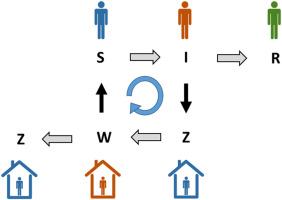大流行防备和通过气溶胶传播的空气传播疾病新模式的发展
IF 1.9
4区 生物学
Q2 BIOLOGY
引用次数: 0
摘要
目前,流行病和大流行中空气传播疾病的大多数计算模型都是基于易感-感染-康复(SIR)模型族。虽然这些模型适用于描述通过直接接触传播的疾病,例如面对面咳嗽,但它们不太适用于通过气溶胶传播的疾病。在这项研究中,描述了气溶胶和空气传播传染因子的一般数学公式。该公式利用多元人口平衡方程PBE框架,不仅考虑受感染的个体,还考虑受感染的室内空间。这些PBEs比SIR模型复杂得多,需要简化为适合计算模拟的简化模型。本研究提出了两个层次的简化模型,包括单变量PBEs和隔室总体水平描述。演示了如何提取SIR模型,以及如何确定最简单的可能的气溶胶SIR模型A-SIR。SIR和A-SIR模型在不同的情景下进行了比较,结果显示出显著不同的动态和结果。最后,PBE方法似乎避免了文献中提到的SIR模型的许多缺点,并支持与其他建模方法的集成。本文章由计算机程序翻译,如有差异,请以英文原文为准。

Pandemic preparedness and new model developments for airborne diseases transmitting via aerosols
Currently most computational models for airborne disease transmission in epidemics and pandemics are based on the Susceptible-Infected-Recovered, SIR, family of models. Although these models are suitable for describing diseases transmitting by direct contact, e.g., face-to-face coughing, they are less suitable for diseases transmitted by aerosols. In this study a general mathematical formulation for aerosol and direct transmission of an airborne infective agent is described. The formulation utilizes a multivariate population balance equation, PBE, framework that considers not just infected individuals but also infected indoor spaces. These PBEs are significantly more complex than SIR models and require simplifications to reduced models suitable for computational simulations. In this study two levels of reduced models are presented including univariate PBEs and compartment population level descriptions. It is shown how the SIR model can be extracted but also how the simplest possible aerosol SIR model, A-SIR, can be determined. The SIR and A-SIR models are compared for different scenarios and are shown to present significantly different dynamics and outcomes. Finally, the PBE approach appears to avoid many of the shortcomings of the SIR models noted in the literature and enables integration with other modeling approaches.
求助全文
通过发布文献求助,成功后即可免费获取论文全文。
去求助
来源期刊

Biosystems
生物-生物学
CiteScore
3.70
自引率
18.80%
发文量
129
审稿时长
34 days
期刊介绍:
BioSystems encourages experimental, computational, and theoretical articles that link biology, evolutionary thinking, and the information processing sciences. The link areas form a circle that encompasses the fundamental nature of biological information processing, computational modeling of complex biological systems, evolutionary models of computation, the application of biological principles to the design of novel computing systems, and the use of biomolecular materials to synthesize artificial systems that capture essential principles of natural biological information processing.
 求助内容:
求助内容: 应助结果提醒方式:
应助结果提醒方式:


